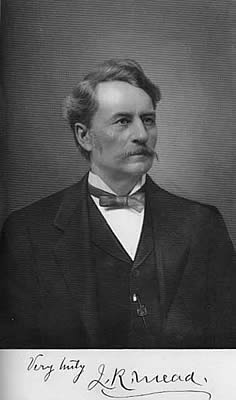James R. Mead (pioneer) facts for kids
James R. Mead (born May 3, 1836 – died March 31, 1910) was an important figure in early Kansas history. He was a "plainsman," meaning he explored and lived on the vast plains. He was also a "pioneer," one of the first settlers in a new area. Mead helped found the city of Wichita, Kansas. He also served as a state legislator, which means he helped make laws for Kansas.
James R. Mead worked to protect the rights of Native American tribes in Kansas. He also helped guide huge cattle drives along the famous Chisholm Trail to Wichita. In 1871, he played a key role in bringing the railroad to Wichita, which helped the city grow. Mead loved learning about nature (biology) and different cultures (ethnology). Later in his life, he wrote many articles about his experiences. His memories were published in a book called Hunting and Trading on the Great Plains 1859-1875.
Contents
James R. Mead's Life Story
James R. Mead was born in New Haven, Vermont. His father, Enoch Mead, was a Presbyterian minister. In 1837, his family moved to a farm near Davenport, Iowa. This is where James learned to love nature and the wild American frontier.
When he was 14, he went to a preparatory school in Davenport. He also spent a year in college when he was 19. In 1859, James R. Mead rode from Iowa to Kansas Territory. He quickly became involved in trading with Native American tribes.
Mead was a Kansas pioneer and a smart businessman. In 1864, he set up a trading post in the Arkansas Valley. This was the very first building on the land that would become Wichita. He was very important in helping to create and develop this city.
Later, he served in the Kansas State Senate. One of his early business partners was Jesse Chisholm. Chisholm had a trading post in what was then called Indian Territory. Chisholm often traveled north to get supplies from Mead during the American Civil War. This frequent route became known as the Chisholm Trail. In 1871, Mead was the main person who pushed to bring the railroad from Newton down to Wichita.
Mead was always interested in old artifacts (archaeology), nature (natural history), and different cultures (ethnology). He wrote many articles for the Kansas State Historical Society and the Kansas Academy of Sciences. Later in his life, he shared his memories of his early days in Kansas. These stories were published in his book, Hunting and Trading on the Great Plains, 1859 - 1875.
Exploring the Great Plains
James R. Mead arrived in Kansas Territory in 1859. He was 23 years old. At that time, the land was the traditional home of many Native American tribes. These included the Osage, Kansas, Kiowa, and Comanche tribes. Millions of buffalo still roamed freely across the plains. They stretched from Canada all the way to southern Texas.
Important trails like the Santa Fe Trail and the Oregon Trail crossed through Kansas. The Santa Fe Trail started near Westport, Kansas. Wagons carried thousands of pounds of goods. They were pulled by many oxen or mules all the way to Santa Fe. This constant travel wore a wide, smooth path, sometimes 60 to 100 feet wide.
Mead arrived when Kansas was a "hunter's paradise." There were no railroad tracks in the territory yet. He hunted in the Smoky Hills near the Saline River (Kansas). He described the land like this: 'The whole country had the appearance of a well-kept park belonging to some English nobleman. The grass was eaten down close by the buffalo and paths ran in every direction. The country was well watered by pure streams fringed by belts of timber and the high buttes were clothed with grass to their summits.'
In 1860, Mead set up a camp on Spillman Creek. This was northwest of where Salina is today. For several years, he traded with the Sioux, Cheyenne, and Kaw Native American tribes. However, challenges with some tribes made him decide to move for his family's safety.
In the summer of 1863, Mead left the Smoky Hills. He established a new trading post at Towanda in Butler County, Kansas. For the next few years, Mead ran his trading post successfully. He continued trading with various Native American tribes. He also supplied other traders, including Jesse Chisholm.
Important Meetings and Treaties
On October 17, 1865, the United States government and many major Plains Native American tribes signed a treaty. This important meeting happened on the Little Arkansas River. It was there that Mead first met the famous frontiersman, Kit Carson. Carson was representing the government at the treaty signing. A treaty is a formal agreement between groups or nations.
Building a City: Wichita
In 1868, James R. Mead worked with Governor Crawford and others. They officially "incorporated" the town of Wichita. This means they formally created it as a legal town. Mead insisted on naming the town Wichita. This was because the Wichita Native American tribe had lived on that land for several years.


